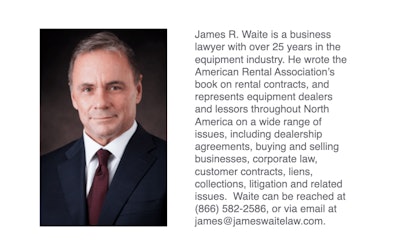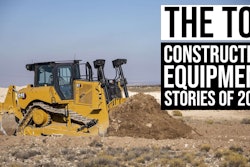
Relationships between manufacturers and dealers take many forms.
Some are extraordinarily collaborative and involve a great deal of mutual input regarding equipment, facilities, staffing, markets and other competitive issues, while others take a more “top-down” approach, with the manufacturer dictating most of the rules pertaining to how and when its equipment is bought and sold.
State equipment dealer statutes commonly alter this arrangement to a greater or lesser degree (generally, to the benefit of dealers), depending on where the parties are located and which statute(s) might be found to apply. Not surprisingly, dealership agreements tend to (imperfectly) reflect this; some being as short as a few pages; with others going on for 100 pages or more.
Why? In many ways, a dealership is like a partnership. Among other things, the parties need to decide who runs things, how they will be run, who will pay for what, and what happens if and when the relationship expires or terminates.

But that’s really just the starting point. Consider this: After a dealer buys a fleet of equipment and pays (or signs a contract agreeing to pay) for it, the dealer is in an extremely compromised (weak) negotiating position with respect to a long list of issues, including:
- Cost and availability of additional fleet
- Financing terms
- Parts pricing and availability
- In-territory sales by other dealers
- Warranty obligations
- Specialized tooling needs
- Replacement equipment availability and cost
- Marketing and advertising obligations and OEM support
- Software support
- Staffing requirements
- Facilities requirements
- Customer financing options
- Expansion opportunities
- Rights upon termination.
“Give me some examples.”
Over the years, we’ve seen a wide range of issues arise, including price changes by manufacturers, OEM modifications of dealer financing terms, remote dealers selling into exclusive territories without paying overrides or commissions, and supply chain issues that result in a dealer’s inability to obtain repair/replacement parts and equipment for extended periods.
Other issues include the withdrawal or modification of customer financing programs, a dealer’s inability to obtain manufacturer approvals for the sale of their business, OEM-threatened terminations based on technical contract breaches such as intermittent failures to maintain staffing levels or marketing expenditures, and the OEM refusal to repurchase equipment upon termination.
This imbalance results from a number of factors, not least of which is the fact that dealers, even large ones, generally don’t have as much money or legal support as manufacturers, not to mention the fact that in most cases, an individual dealer will have already purchased and paid for (or financed) an entire fleet of equipment and all of the necessary infrastructure and support by the time an issue arises.
The disparity in negotiating power was first widely recognized by state legislatures in the early part of the 20thcentury, with the expansion of the automobile industry. Auto dealers, as you probably recognize, tend to face many of the same issues equipment dealers are forced to address when dealing with large, well-capitalized manufacturers who often keep entire legal departments and dozens of lawyers busy making certain these manufacturers maintain every possible legal advantage with respect to their dealer networks.
Not surprisingly, in response to this, states have responded by enacting laws designed primarily to protect dealers and ensure they’re treated fairly with respect to the above referenced issues – though to widely varying degrees.
This is not to suggest that all, or even many, manufacturers treat the dealers in their networks unfairly. In fact, we find that most manufacturers understand and appreciate the need to maintain positive relationships with their dealer networks – bearing in mind, that as perceived by most lawyers, the term “positive” more often means “advantageous” than it does “mutually beneficial.”
For dealers, however, this perception coupled with the often mistaken belief that “surely there’s some law that will protect me” and a desire to “just get going” can create a dangerous (and false) sense of security. In far too many cases, the first time a dealership agreement gets a close look is either when: (a) a sudden need arises (for example, an opportunity to buy a large amount of equipment from a third party at a reduced price, or perhaps a potential business sale); or (b) after something has gone seriously wrong in the relationship.
Only then does the dealer realize how strong or weak its negotiating position really is. In either case, it’s usually too late to do much more than suffer the indignity of going to a manufacturer hat-in-hand and asking for concessions, or keep quiet and hope no one finds out, or commence litigation or arbitration. Obviously, none of these options has much appeal to most dealers, but how can dealers avoid finding themselves in this position?
Laws and agreements
For most dealers, there are really only two alternatives: attempting to access a favorable state dealer law and/or negotiating a reasonable dealership agreement up front.
For the first part of this article, which will be in two parts, let’s first look at dealer laws around the country and how they can impact the situation. In Part 2, we will take a closer look at dealership agreements and how they can help.
Unlike franchise statutes (which also may apply to dealership arrangements), state dealer laws tend to be product- and/or industry-specific. All that is generally required is the existence of a contract between a supplier and an equipment dealer that sets forth the rights and obligations of each party pertaining to purchases and sales of equipment. Other “franchise” concepts, such as trademark licensing, marketing plans, franchise fees tend to be largely ignored.
This creates some flexibility, but can also result in confusion regarding whether a state statute applies to a given type of dealership at all. For example, Arizona’s broadly named “Equipment Dealers” law actually applies only to dealers of “machines designated for or adapted and used for agriculture, livestock, grazing, light industrial and utility purposes,” and specifically excludes earthmoving, heavy construction, mining and forestry equipment.
Conversely, some states, such as Wisconsin, have uber-expansive dealer laws that cover effectively everything. Wisconsin’s law defines a “dealership” to include “an agreement by which a person is granted the right to sell or distribute goods or services … at wholesale, retail, by lease, agreement or otherwise.”
State dealer laws can also vary substantially in terms of what they actually require of/for the dealerships they do govern.
For example, some prohibit substantial changes by manufacturers to pricing, terms and/or other requirements in the absence of “good cause,” while others may require extended notice periods for material modifications. Additionally, most dealer statutes require manufacturers to repurchase all or some portion(s) of a dealer’s inventory, parts, specialized tooling, computer hardware, software and/or other items, but they may do so at vastly different levels and/or prices, particularly with respect to imperfect or partially used equipment and/or parts.
It can therefore be crucial to know which state laws best serve your interests and, in some cases, to include a contract provision requiring application of the most favorable of such laws – with the knowledge that many (though certainly not all) states make a practice of simply applying the law of the state in which the dealership is located, regardless of what the dealership agreement might require.
What about the courts?
After you’ve managed to unpack all of that, you will need to factor in the range of judicial interpretations rendered by the various state, federal and appeals courts, which can themselves be unpredictable.
For instance, in Southern Implement v. Deere & Co. (122 F.3d 503), a manufacturer’s inaction in response to encroachment by dealer on area of another dealer was deemed to not constitute a “change in competitive circumstances” prohibited under the statute.
In other words, the manufacturer could not be held liable for failing to ensure that another dealer did not encroach upon Southern Implement’s territory.
In another case, Gravquick A/S v. Trimble Navigation International Ltd. (303 F.3d 1291, 9th Cir, 2003), a California manufacturer was able to require the application of California law under its dealership agreement against a dealer seeking to apply laws of the dealer’s state.
In Denner Enterprises, Inc. v. Barone (87 P.3d 269; Colo. Court of Appeals, 4th Div., 2004) a manufacturer was not required to repurchase equipment a dealer bought after receiving notice of termination of the dealer agreement from the OEM. This, even though the manufacturer gave the dealer an additional 90 days to make purchases after termination.
In this case, the dealer purchased the equipment and then tried to return it, but the manufacturer refused to accept it. The court said that the agreement was terminated upon giving of the original notice by the manufacturer – therefore, the dealer’s return right was terminated with it.
And in Taylor Equipment, Inc., dba Midcon Equipment Company, v John Deere Company (S.D., 10/18/96, Nos. 95-2937, 95-3000): The manufacturer refused to approve Midcon’s proposed assignment of its dealership to a willing buyer, forcing Midcon’s owners to sell the business to a different buyer for $1,715,000 less.
The dealer agreement provided that Midcon could not assign its dealership “without the prior written consent of [the manufacturer].” Critically, it did not require the manufacturer to act reasonably. The Appeals Court, therefore, deemed the restriction enforceable. (Also note that a Maryland Appeals Court ruled similarly in Enfield Equipment Co. v. John Deere Company (4 Cir. Ct. Appeals, 2000).
Please note that repurchase obligations often prove to be a critical issue and that they can vary dramatically from state to state. As noted above, most dealer statutes impose repurchase obligations on manufacturers to one degree or another, and often go on to invalidate contract provisions to the contrary.
Some, however, appear at first glance to do so, but then back away from these important requirements in whole or in part. For example, Pennsylvania’s dealer statute includes the following language at the end of a lengthy repurchase obligation:
“In the event a dealer terminates a dealer agreement, the obligation of the supplier to repurchase equipment, repair parts and specialized repair tools shall be governed by the terms and conditions then in effect in the dealer agreement between the supplier and the dealer and not by the provisions of this act.” [Emphasis Added]. 13 Pa.C.S.A. § 205-3(c)(3).
Thus, depending on the circumstances and critically, which state’s laws are deemed to apply, a dealer could be stuck with equipment that the dealer can’t sell, can’t return, and/or can’t support.
This also means that part of the dealer’s analysis should be consideration of the possibility that, even if a given state’s dealership statute does appear to cover the dealer’s equipment, whether or not it supersede your dealership agreement, such as in California; supplement it (such as in Michigan) or be overruled by it (example: Pennsylvania).
Decide what’s most important
Although it would probably be impossible to create a comprehensive list of considerations for every prospective dealer, several issues tend to stand out, and usually merit advance research and consideration, including:
Coverage: You need to know whether your dealer statute covers your equipment at all. So, start with a review of the “definitions” section, usually contained in the first few paragraphs of the statute. In some states, coverage will be unmistakably clear; in others it may be difficult to tell; while in still others, it may be just as clear that your dealer statute offers no help at all (in which case, your operation still might be covered by a franchise statute; at least 16 states and the U.S. Virgin Islands have them, so be sure to check);
Waiver of Statutory Coverage: Next, determine whether and to what extent the dealership statute can be overridden by a dealership agreement.
Modifications: Review the applicable statute for limits on modifications to the relationship. For example, some prohibit modifications that change the “competitive circumstances” of the dealer relationship, while others leave such issues to the negotiations of the parties.
Transferability: Critical to any owner considering, or who may in the future consider, an exit strategy involving a transfer of the dealership, review the dealership statute closely. Some prohibit manufacturers from unreasonably withholding consents to such transfers; others merely require manufacturers to respond to such requests within a given time; and still others ignore the issue altogether.
Notices of default and cure periods: For defaults that might be claimed by manufacturers, including failures to satisfy marketing, employment, budgeting, facilities, purchase and/or resale requirements, check the statute for advance notice-of-termination as well as cure-period requirements. The ability to correct deficiencies before being surprised by a notice of termination can be immensely important not only for purposes of maintaining your dealership, but also your rights upon termination (see “repurchase obligations” below).
Termination (whether good cause is required): Many states require “good cause” (for example, a material failure or series of material failures by the dealer to satisfy the requirements of the dealership agreement or applicable) before the manufacturer can terminate the relationship. Obviously, this creates a measure of security for dealers when purchasing fleets and making commitments with respect to capital expenditures. A number of statutes, however, do not require good cause (or only require it in some cases), including surprisingly Arkansas, Indiana, Iowa, Kansas, Nebraska, Missouri, Montana and New Mexico, leaving the issue to be negotiated by the parties and (perhaps) included in a dealership agreement.
Repurchase obligations: As mentioned above, most states’ statutes include a buyback/repurchase obligation on the part of the manufacturer or distributor. The details of such obligations, however, can vary substantially. All such statutes require the repurchase of equipment (usually, however, only new and unused items – often defined as machines with less than 50 metered hours), but they differ with respect to the amounts required to be paid for such equipment and when – for example, some require the terminated dealer to demand repurchase, while others simply require payment, typically not later than 60 to 180 days following return of the equipment to the manufacturer.
They also tend to vary considerably with respect to required repurchases of parts, supplies, specialized tools, computer hardware and software, signage, marketing materials and other items, not to mention reimbursements for the cost of return packing, handling, loading and/or transportation. Most such statutes also allow dealers to retain any or all of the above if they choose to do that, but it is often unclear whether, if they elect to do so, they will continue to have access to parts, supplies, diagnostic and repair information, software and/or other forms of support after termination.
Know what you’re signing
Dealership arrangements can be immensely valuable, but also risky, for equipment dealers. Where applicable, dealer statutes can do a great deal to mitigate that risk, but they vary dramatically with respect to critical issues such as price changes, payment terms, financing, business transfers, default notices and termination/post-termination obligations of the parties.
If you’re considering entering into a dealer relationship, the place to start legally is with a review and assessment of the applicable state(s)’ dealership statutes – usually best done before commencing contract negotiations with a manufacturer. Knowing what, if any, protections you already have, and what you need to negotiate into a dealership agreement can save you a tremendous amount of time, not to mention legal expense, but preparation is key.
Editor’s note: This is the first of a two-part story. The second part will appear next month.














